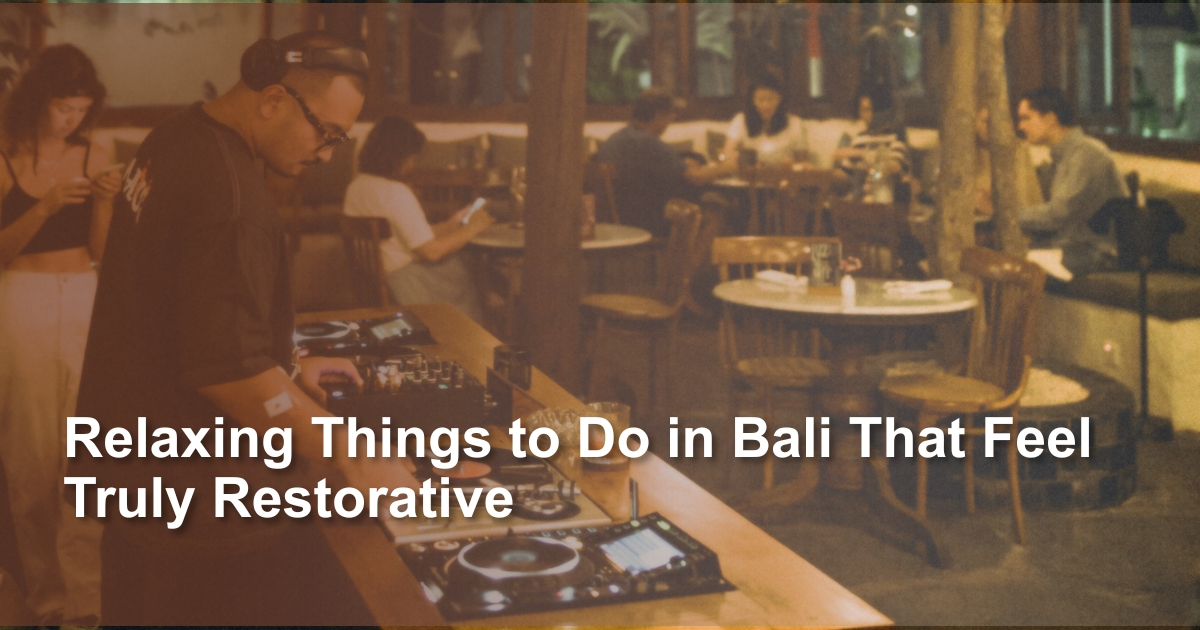When I reflect on my time in Bali, the moments that still light me up are never merely about seeing something new, they’re about being someplace still, breathing deeply, and letting everything settle. Bali is famous for its beauty, but its less-known places and rituals are what bring peace in unexpected ways. I’m sharing what I discovered, not the usual checklist, but the kinds of experiences that made me slow down, feel grounded, and return home changed.
Bali Quiet Escapes for Relaxing Activity
Pandawa Beach at Dawn
One of my best mornings was on Pandawa Beach. Before most beach cafes opened, I walked along the pale sand, the cliffs framing the beach on both sides, the surf gentle. It’s still relatively quiet compared to Kuta or Seminyak. Watching locals push boats into the water, fishermen preparing nets, I felt part of a slower rhythm.
Insider Tip: Stay nearby for sunrise (around 5:45. – 6:15 AM), then find a local Warung for breakfast (nasi goreng + kopi), and relax until mid-morning before crowds arrive.
Sambangan Secret Garden & Waterfalls in North Bali
If you’re okay with a drive, Sambangan in Buleleng (north Bali) offers multiple hidden waterfalls, Aling-Aling, Kroya, secret pools tucked behind tropical jungle. I spent an entire afternoon swimming in shaded pools, listening to water flowing over rocks, green vines dripping. It felt like discovering secret pages in a book.
Cost & Access: You’ll want a local guide (usually ~IDR 150,000 – 250,000 depending on group size) because paths aren’t always obvious. Bring water shoes, sunscreen, and expect muddy/mossy terrain. Great for nature + quiet.
Floatation Tank & Sensory Deprivation in Seminyak
When I felt my mind buzzing (phones, travel, planning, etc.), I tried floating in a dark, soundproof tank at Terapung Float Club in Seminyak. No light. No sound. Your body buoyed by Epsom salts. It’s startling how loud your thoughts can get in silence — but also how healing the silence is when you lean into it.
Expect: ~1 hour, price will depend on what kind of package you take; usually in the mid-range spa price for Bali. Best to go early in the day when you’re not carrying the day’s fatigue.
Melukat (Purification by Water)
I didn’t plan this, but I ended up being invited by a local friend to a Melukat ceremony. We met a priest, made offerings, then were cleansed by sacred water — coconut water, river water, sea water depending on place. When I stepped out, dripping and cleansed, I felt lighter, as if unseen weights had dropped off me.
- Where: Tirta Empul Temple is the most famous; others include Sebatu Holy Spring and rivers/temples in Ubud.
- When: Can be done most days, but authentic experience is richer during certain Balinese holy days.
- Cost: Usually donation-based; sometimes there is a small entrance fee to the temple or guide.
Read also : 7 Non-Touristy Destination You Should Visit in Bali
Sidemen Valley’s Rice Terraces
I chose Sidemen Valley for a multi-day stay when I wanted calm. Mornings I would wander the terraces before sunrise, passing women planting rice, children walking to school, cows grazing. Midday I rested in a hammock with rice views, evening I listened to frogs and insects under starry skies. Sidemen feels intimate — fewer tourists, simpler life, slower pace.
Munduk (Waterfalls + Mountain Quiet)
Munduk in the north is cooler, more forested. One day I hiked among waterfalls, another afternoon read in a lodge overlooking valleys. Peace wasn’t just physical—it was altitude, fewer cars, fewer crowds, mist-shrouded mornings. Great place for retreating inward.
Read also : Things to Do in Munduk, Bali: Guide to Waterfalls, Lakes, and Hidden Gems
FAQs People Often Ask
What’s the best time of year for peace & quiet in Bali?
- Avoid: July, August and mid-December to early January — busiest times.
- Try: April–June and September–October. Wet season (Nov–Mar) has its rainy days, but also quieter. If rains come, you often get huge afternoon storms then clear skies.
How do I avoid tourist traps and crowds?
- Stay outside the main hubs (Seminyak, Kuta). Choose places in North, East, or parts of Central Bali like Sidemen or Munduk.
- Visit hidden beaches or waterfalls early (sunrise or very early morning).
- Book stays in smaller guesthouses or eco-lodges rather than big resorts. Read reviews specifically about quietness, noise, “noise from road,” etc.
What budget should I expect for relaxing wellness experiences?
- Simple local massages: ~IDR 100,000–200,000 depending on location.
- Mid-range spa rituals or multi-step treatments: ~IDR 800,000–1,500,000 (~$50–100 USD) depending on luxury and inclusions.
- Overnight stays in serene places (guesthouses, lodges) in Sidemen or Munduk might run ~IDR 400,000–1,000,000+ per night depending on comfort.
Final Thoughts
Bali has a reputation for its beaches, temples, and nightlife, but what I took home wasn’t just photos of famous sights, it was the feeling of finally slowing down. The quiet mornings in rice terraces, the warmth of a flower bath, the sound of rain on palm leaves, these are the moments that stayed with me long after my flight back.
If you’re planning a trip, don’t try to fill every hour with sightseeing. Leave space for the island to work its quiet magic. Let the days stretch, let the sunrises and sunsets be unhurried, and allow yourself to simply be. Because in Bali, relaxation isn’t something you plan for, it’s something the island gently teaches you, one peaceful moment at a time.










